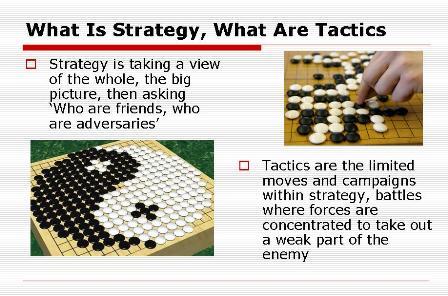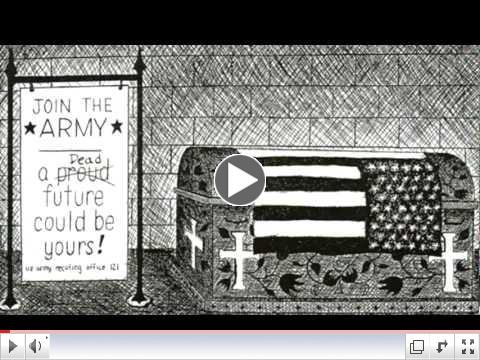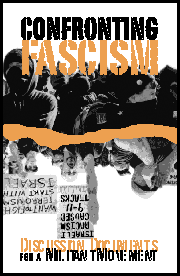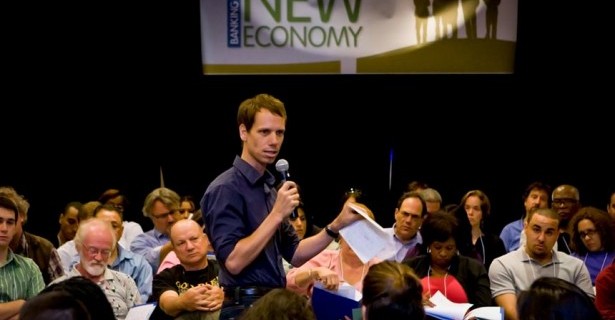 | |
Lost Sessions Found:
Johnny Cash with Waylon Jennings - I'm Movin' On
|
|

Jackson Rising:
New Economies Conference
|
 | |
Journal of the Black Left Unity Network
|
|

New CCDS Book Reporting on Vietnam
|
 The new annual edition of our journal of discussion and analysis is now out. More than 130 pages, it includes 20 articles on organizing, racism and the right. Cost is $10 plus shipping. Or get one by becoming a sustainer. Click the title to buy it directly. The new annual edition of our journal of discussion and analysis is now out. More than 130 pages, it includes 20 articles on organizing, racism and the right. Cost is $10 plus shipping. Or get one by becoming a sustainer. Click the title to buy it directly.
|
Blog of the Week... 
|
|
Radical Jesus:
A Graphic History of Faith  By Paul BuhleHerald Press By Paul BuhleHerald Press
|

Check out what CCDS has been doing...
|
 Keep On Keepin' On Keep On Keepin' OnWhy Socialists Run in Elections, Strategy and Tactics Slide Slow, Class and Privilege, the Green New Deal ...and other Short Posts on Tumblr by Carl Davidson
|

Edited by Carl Davidson Revolutionary Youth the the New Working Class: The Praxis Papers, the Port Authority Statement, the RYM Documents and other Lost Writings of SDS
Changemaker, 273pp, $22.50
For the full contents, click the link and view 'Preview' under the cover graphic.
|
|
By Randy Shannon, CCDS

"Everyone has the right to work, to free of employment, to just and favorable conditions of work and to protection against unemployment."
- United Nations Universal Declaration of Human Rights, December 10, 1948
I. Introduction
The "Great Recession" that began in 2007 has caused the greatest percent of job losses since the Great Depression of 1929. This crisis is the end of an era of unrestrained 'neo-liberal' capitalism that became public policy during the Reagan administration. The crisis marks a new level of instability with the growth of a global financial elite that targeted US workers and our trade unions after World War II.
|
|
Order Our
Full Employment Booklets
 |
...In a new and updated 2nd Edition
Capitalism may well collapse under its own excesses, but what would one propose to replace it? Margaret Thatcher's mantra was TINA...There Is No Alternative. David Schweickart's vision of "Economic Democracy" proposes a serious alternative. Even more fundamentally, it opens the door to thinking about alternatives. His may or may not turn out to be the definitive "successor system," but he is a leader in breaking out of the box. |
 by Paul KrehbielAutumn Leaf Press, $25.64
by Paul KrehbielAutumn Leaf Press, $25.64 | | Shades of Justice Video: Bringing Down a President, Ending a War |
|
 By Giuseppe Fiori
Verso, 30 pages
|

Essays on Mondragon, Marx, Gramsci
and the Green and Solidarity Economies |
Solidarity Economy:What It's All About

Edited by Jenna Allard, Carl Davidson and Julie Matthaei
Buy it here...
|

- Foreword by Susan Brownmiller
- Preface by Ken Wachsberger
$37.50 + $6 shipping
|
|
Discussion Documents for a Militant Movement

By Don Hamerquist
|
|
|
|
An Invitation to CCDSers and Friends...
 Progressive North Progressive North
Carolina is Rising
We're the Committees of Correspondence for Democracy and Socialism...Do you have friends who should see this? Pass it on...Do you have a blog of your own? Others you love to read every day? Well, this is a place where you can share access to them with the rest of your comrades. Just pick your greatest hits for the week and send them to us at carld717@gmail.com!
Most of all, it's urgent that you oppose war on Iran, defend voter rights, plan for 2014 races now, oppose austerity, support the 'Moral Mondays' in North Carolina, the Congressional Progressive Caucus' 'Back to Work Budget'! We're doing more than ever, and have big plans. So pay your dues, make a donation and become a sustainer. Do it Now! Check the link at the bottom... |
Up to 100,000 in 'Moral March' in Raleigh

GOP Legislators Targeted for Austerity
and Denial of Rights By Thomasi McDonald
News Observer via Beaver County Blue
Feb 8, 2014 - RALEIGH - State NAACP President William J. Barber II laid out goals for a diverse coalition of groups Saturday afternoon at a rally attended by thousands of people from all over the state and the nation who marched, sang, chanted, cheered and even danced through downtown Raleigh.
 Organizers said the "Mass Moral March" was intended to push back against last year's Republican-led legislation in North Carolina. Barber called for well-funded public education, anti-poverty policies, affordable health care for all that includes the expansion of Medicaid, an end to disparities in the criminal justice system on the basis of class and race, the expansion of voting rights and "the fundamental principle of equality under the law for all people."
"We will become the 'trumpet of conscience' that Rev. Dr. Martin Luther King Jr. called upon us to be, echoing the God of our mothers and fathers in the faith," he said. "Now is the time. Here is the place. We are the people. And we will be heard."
The mammoth crowd that gathered in downtown Raleigh represented a variety of causes that joined last year's Moral Monday protests, but the event also brought in groups and individuals usually on the fringes of state politics.
Susan Fariss of Mocksville drove three and a half hours to hold up a sign supporting the legalization of medical marijuana.
"I have several health problems that cause me pain," Fariss said. "I have tried Vicodin and different muscle relaxers, but no matter what I've tried, I'm in pain. My doctor told me he could not prescribe it, but he recommended medical marijuana."
Holiday Clinkscale, 60, of Raleigh climbed atop a big potted plant on Fayetteville Street and twirled an American flag above his head. He wore a leather jacket decorated with red, white and blue stars and stripes. Clinkscale wore the regalia on behalf of "depressed" African-American men.
"Black men in Raleigh couldn't wear red, white and blue after the Civil War when we were freed, or they would have been executed," he said. "You see a lot of black men here today looking depressed."
Wake County attorney Daryl Atkinson was at the march, but the look on his face was one of purpose....(Click title for more)
|
|
Liberal Talking Points Won't Do, Shatter the Tea Party with the US Constitution Itself  Who can Stop the Tea Party movement? (left to right: Karl Rove, Senator Chuck Schumer, North Carolina NAACP leader Rev. William Barber II) Who can Stop the Tea Party movement? (left to right: Karl Rove, Senator Chuck Schumer, North Carolina NAACP leader Rev. William Barber II)
Cut the Tea Party Movement from the Ground Up
By Leonard Zeskind
Progressive America Rising via IREHR
Recently Sen. Charles Schumer made a groundbreaking speech outlining a Democratic Party strategy aimed at the Tea Parties. For the first time, a major figure in the liberal political universe sought to both explain the Tea Parties' appeal to tens of millions of adult Americas and to project a strategy to break the Tea Party base away from its leaders-at least in the context of election campaigns.
Mr. Schumer's was wrong in his description of the Tea Party movement, however, and his proposed strategy was little more than a campaign statement that would do little damage to the Tea Parties.
It should be noted that Republican Party operatives such as Karl Rove had already set the Tea Parties in their sights, planning to drown them with a sea of adverse money and media during the upcoming Republican primaries. The prospects for Republican Chamber of Commerce-types beating down the Tea Party grew dimmer recently, however.
Witness the recent imbroglio over immigration reform. Speaker John Boehner-in line with Rove's general strategy-outlined possible points for bi-partisan agreement on immigration reform.
But the Tea Party movement and other hard right organizations pushed the whole project into the dirt. The Tea Parties were the ones swamping Republican congressional reps with negative phone calls and emails from their constituents. As a result, immigration reform is now off any Republican legislative agenda, and the Tea Party movement can claim victory. Remember, in 2013, Tea Party groups raised more than double the funds that Rove did, according to the February 1, New York Times. Not much of a strategy for Mr. Rove.
Sen. Schumer's talk garnered more than the usual media attention conferred on a politician's speech at the Center for American Progress Action Fund. The New York Times accorded it positive coverage and virtually thirteen column inches of text, plus a picture and headline. The Wall Street Journal as well as smaller city dailies respectfully covered the senator's talk.
The conservative and Tea Party blogosphere gave Schumer short, negative attention. An interesting piece by Kelsey Osterman, writing on Red Alert Politics, a website describing itself as written by and for young conservatives, asserted that Schumer's proposed strategy "isn't going to work." Why? Osterman asked: "Because Schumer fundamentally misunderstands the grassroots movement."
The young conservative has this point. In Schumer's case, because he broached issues that went beyond any narrow election-year Democratic Party strategy, IREHR believes his project bears further discussion.
The Institute for Research & Education on Human Rights (IREHR) has been closely studying the Tea party movement since 2009, and we have our own criticisms of Schumer's understanding of that far right, anti-democratic movement.
Indeed, Schumer does not even accord it "movement" status, referring to it instead as "the Tea Party." As such, he fails to acknowledge the fact that multiple national organizations, as well as state and local groups, all comprise this phenomenon. That is over half a million members, six to eight million supporters, and 22% of adult population. Sometimes these multiple organizations act in unison, but it is more often that they have competing and conflicting goals. Any reasonably adept opponent of the Tea Party movement would, for example, take advantage of the fact that the head of Tea Party Nation openly worries about the end of "Anglo-Saxon" hegemony, while FreedomWorks' Matt Kibbe would consider such verbiage off-limits.
The open racism and Christian nationalism among some Tea Party leaders is at odds with the views of other Tea Party leaders. As such, Tea Party Nation's leader is one of the greatest weak spots in the Tea Party movement's armor. There are multiple such weak spots.
Sen. Schumer delineates his Tea Party into "Tea Party elites" that manipulate and mislead the "average grassroots Tea Party follower." This formulation is misguiding on several significant points.
Consider Jenny Beth Martin, for example, a Tea Party Patriots national coordinator. Readers will look at IREHR's recent report on Tea Party membership and note that this national organization is the second largest of all the national factions. She has considerable organizational weight behind her and during the recent immigration battle with Boehner managed to "set in motion 900,000 automatic phone calls in 90 Republican House districts connecting tens of thousands of voters to their members of Congress," according to the February 8 New York Times.
As IREHR previously reported, however, in 2008, during the summer before the Tea Parties emerged, Jenny Beth Martin declared bankruptcy from her home in an Atlanta suburb. She is not an "elite" in the ordinary use of the term. Neither are any other Tea Party leaders, except perhaps, Dick Army, the former congressman who once led the FreedomWorks Tea Party. Neither should these leaders be considered "elites" simply in terms of their status within their movement, a movement which generally eschews elites. ...(Click title for more)
|

By Mike Elk
In These Times
Volkswagen employees go to the polls on Wednesday, but will state politicians' threats affect their union election?
In the run-up to a union election, workers typically run a gauntlet of threats from management, including claims that a vote to unionize will jeopardize their jobs by hurting the company's bottom line.
 But in the case of an upcoming union election for Volkswagen's 1,600-worker auto plant in Chattanooga, Tenn., set to run from February 12-14, the company has pledged to remain neutral during the union drive. Last week, Volkswagen even invited the United Auto Workers (UAW), which is vying to represent the workers, to come and make a pre-election presentation at the plant. But in the case of an upcoming union election for Volkswagen's 1,600-worker auto plant in Chattanooga, Tenn., set to run from February 12-14, the company has pledged to remain neutral during the union drive. Last week, Volkswagen even invited the United Auto Workers (UAW), which is vying to represent the workers, to come and make a pre-election presentation at the plant.
While Volkswagen has vowed not to interfere, however, outside forces have picked up the anti-union playbook and are telling workers that choosing union representation could endanger their jobs. At a press conference on Monday, Tennessee Republican State Senate Speaker Pro Tempore Bo Watson and Republican House Majority Leader Gerald McCormick implied that state subsidies to Volkswagen could be blocked if the plant unionizes.
"Should the workers at Volkswagen choose to be represented by the United Auto Workers, then I believe any additional incentives from the citizens of the state of Tennessee for expansion or otherwise will have a very tough time passing the Tennessee Senate," Watson said at a press conference Monday in Chattanooga, according to online newspaper The Chattanoogan. "The workers that will be voting, need to know all of the potential consequences, intended and unintended, should they choose to be represented by the United Auto Workers."
Democrats and union supporters reacted with indignance to what they perceived as a thinly-veiled challenge to workers' collective-bargaining rights at the behest of state officials.
"It's an outrage that state Republican leaders would threaten jobs at the Volkswagen plant by claiming they would vote against incentives to their employer if the workers choose to unionize," said Democratic State Rep. Sherry Jones in a statement released by the UAW. "We should all reject the type of scare tactics and misinformation coming from special interest groups and Republican elected officials."
Though Volkswagen does not oppose unionization at the Chattanooga plant, a fight has been brewing with outside anti-union groups, who are throwing their weight around in an attempt to influence the union vote at Volkswagen. In November, Working In These Times obtained leaked documents from Matt Patterson, a Grover Norquist-backed political operative, outlining how he intended to spend hundreds of thousands of dollars to persuade workers to vote against the UAW. A top anti-union consultant also told In These Times that national anti-union groups were gearing up to fight the UAW at Volkswagen in order to prevent the union from gaining a foothold as it seeks to organize other plants across the South.
Now, this fight appears to be kicking into high gear. ...(Click title for more)
|
 The NPA is no longer satisfied with protesting the powerful and aims to help the powerless take the reins instead- through elections, and also through greater worker decision-making power in workplaces. And it is thinking not just in months or years, but in decades. The NPA is no longer satisfied with protesting the powerful and aims to help the powerless take the reins instead- through elections, and also through greater worker decision-making power in workplaces. And it is thinking not just in months or years, but in decades.
By David Moberg
In These Times
As a hungry young drifter who had only recently (and barely) finished high school in the late 1980s, George Goehl (pronounced "gale") got by with a little help from a free soup kitchen in Bloomington, Ind.
A few years later, that kitchen served as the launching pad for his dynamic career as a community organizer. For the past six years, as executive director of the community-organizing network National People's Action (NPA), Goehl has spurred a rapid growth. More important, he is spearheading a dramatic transformation of NPA's strategy and goals-while helping to unleash more of the progressive potential of the large and uniquely American community organizing movement.
Goehl's first political awakening came after he had returned to the soup kitchen as a volunteer in 1990. One day, it hit him that many of the patrons from years earlier were still regulars: The kitchen, part of our country's tattered safety net, had kept them alive, but it had not reduced poverty, generally or individually. He began discussing the root causes of poverty with the kitchen's patrons. Then, with tips from a mentor he met at a tenants' organizing conference, he transformed the talkfest into the Coalition of Low-Income and Homeless Citizens. His work caught the attention of Shel Trapp, an organizer and a disciple of Saul Alinsky, the founder of modern community organizing.
Trapp recruited Goehl to study the craft in Chicago's hard-pressed West Side neighborhoods in 1996. Goehl dutifully learned the commandments of traditional Chicago-style community organizing: Don't talk ideology, just issues. No electoral politics. Build organizations, not movements. No coalitions: Protect organizational turf. Focus on neighborhoods and on concrete, winnable goals. Goehl quickly recruited hundreds of new members to Blocks Together, then an allied organization of National People's Action, his first association with the multi-state network of community groups founded in 1972 by Trapp and the brilliant neighborhood leader Gale Cincotta.
NPA won widespread admiration for its 1977 success in getting Congress to pass the Community Reinvestment Act, which prevented banks from engaging in the practice known as redlining: disinvesting in poorer, seemingly riskier neighborhoods. But Goehl grew frustrated with the limits to his community organizing work. He thought that NPA had become too preoccupied with enforcing its landmark legislative victory and had failed to press onward to bigger goals, such as breaking up the banks or further regulating the industry.
And Goehl grew frustrated, too, with Alinsky-style organizing. Community organizing was dominated by several large networks, each with its own training centers, styles and goals, which had accomplished a lot: helping members deal with local problems and sometimes tackling bigger issues such as homeownership, energy policies or healthcare. But Goehl, like many other critics, thought that these community organizations lacked the ambition, vision, strategy and full arsenal of political weapons needed to roll back decades of corporate conservative victories and to create a more democratic economy and government. One big flaw in traditional organizing was that it was "designed to win the best things possible for a landscape we had not created," Goehl says.
Goehl left NPA in 2004 for a stint as an organizer for the Fair Immigration Reform Movement (FIRM). There, he had a second political awakening: "A lot of people came in [to immigrant rights organizing] with a political analysis first, then [learned] organizing," Goehl says. "For me, my politics developed after my organizing skills. I would be in a room like this"-he gestures to the spartan basement of the NPA's national headquarters in Chicago-"and almost all of the organizers were immigrants, and their ideas around movements, strategy and political analysis were so different from anything I'd experienced in the Chicago school of organizing- so much more expansive, broad and complicated." At FIRM, Goehl began to understand the value of flexibility in adopting new tactics and strategies, as well as collaborating with different groups to build movements.
When Goehl returned to NPA six years ago as executive director, he found most of his staff and community leaders open to a bolder strategy. ...(Click title for more)
|
Bridging the Chasm between Environmental and Economic Justice
 A conversation with activists Bill Fletcher, Jr., and Bill Gallegos, with Anne Lewis A conversation with activists Bill Fletcher, Jr., and Bill Gallegos, with Anne Lewis "Clean Air, Good Jobs, and Justice for All." March on the Detroit Incenerator, U.S. Social Forum, 2010.
By Anne Lewis
The Rag Blog
Feb 11, 2014 - Steelworkers President Leo Gerard said about the choice between a clean environment and good jobs, "You can have both, or you have neither." A rift exists between those good trade unionists who fight for decent jobs and a just economy, and those good environmentalists who fight for a planet where all human beings can be healthy.
In the Appalachian coalfields, the same corporations who deliberately keep non-coal jobs out of the region and blast the mountains apart for greater profits lie to mining communities that the reason for layoffs is the Environmental Protection Agency's so-called "War on Coal." An eastern Kentucky retired miner writes, "I prefer dirty coal over 'Christmas in Appalachia' pity," not recognizing greater options.
And so three activists decided to have a conversation about jobs and the environment. Bill Fletcher is committed to economic justice and working class solidarity. Bill Gallegos is dedicated to the environmental justice and climate justice movements. Anne Lewis is a documentary filmmaker with deep interests in labor and environmental justice.
We decided not to hold back from material and political divisions, or from the imagination that has built concrete experiments for unity.
Anne Lewis: You're coming at this from different angles than the usual talk about jobs and environment. Bill Gallegos, describe the difference between environmental justice and mainstream environmental groups.
Bill Gallegos: The environmental justice movement emerged from the struggle for equality and self-determination of oppressed communities of color. Our focus is on addressing the disproportionate pollution burden borne by communities of color and poorer white communities. Native Americans, African Americans, Latina/os, Asian Pacific Islanders, and working class whites often live near freeways, power plants, toxic waste sites, oil refineries, rail yards, chemical plants and other major sources of pollution.
So our base is among working class people of color and working class white folk (in coal country especially). The strength of the environmental justice community is very close to the ground and at the local and regional level where they have achieved many victories over the last several years - closing down coal-fired power plants, stopping oil refinery expansion projects, and the build-out of natural gas power plants, creating local clean energy projects, developing urban organic farms, and so on.
Many of the major big green groups like the Sierra Club and the World Wildlife Fund have a conservation history, seeking to preserve or develop parks and natural spaces. Their base is largely white and middle class, and their orientation has mostly been legal advocacy and lobbying especially at the federal level.
The green groups recently invested huge amounts of resources in an unsuccessful effort to pass federal climate and energy legislation. One of the central features of this legislation was a pollution-trading scheme that would have allowed industrial polluters to avoid reductions at the source if they purchased pollution permits or created offset projects, for example planting trees in Mexico or some other place. The idea is that the trees would eventually absorb enough carbon to "offset" the emissions from, say an oil refinery in California.
The environmental justice community is strongly opposed to pollution trading because it had failed in Europe (levels of emission actually increased); would do nothing to stop the harm to people in communities near the source; and often displaced local peoples in the Global South from their land.
The environmental justice community reached out to the green groups to discuss our concerns around pollution trading and other problems with the proposed federal legislation. The green groups dismissed our concerns with little serious consideration of the evidence we presented or our proposals for alternative ideas to reduce greenhouse gas emissions.
While there are examples of local collaboration between environmental justice and green groups, major problems continue to characterize this relationship. The green groups receive more than 95 percent of all foundation monies allocated for environmental work. They tend to pursue top-down lobbying and legal strategies, which leads them to unacceptable compromises because they do not want to jeopardize their "relationship" with elected officials or agency regulators. And most green groups continue to support problematic climate policies such as pollution trading, natural gas as a replacement for coal, and offset programs. The environmental justice community unanimously opposes these policies.
At this point everyone agrees that there is no real chance of achieving federal climate and energy legislation because of opposition from the Republican right wing. This means that the game is now local and regional, which is the strength of the environmental justice community.
This creates a new opportunity for the environmental justice movement and the green groups to collaborate, but this collaboration will require the green groups to recognize and accept environmental justice leadership, work with the philanthropic community to address the problem of funding inequality, and re-think their failed policies like cap and trade. There are efforts to build this type of collaboration and I am optimistic that real change could happen.
Lewis: Bill Fletcher, is there a comparison in the relationship between big labor and economic justice with the relationship between big green and environmental justice?
Bill Fletcher, Jr.: First, I don't think that one's approach or attitude towards economic justice necessarily leads one to a progressive position on the environment. There are a lot of trade unionists who are very good fighters, are into class struggle, but are weak or silent on the environment. So I don't think there's a one-to-one correspondence.
When you look at what we know as organized labor, you have institutions much like the big greens that Bill Gallegos described, that were constructed as a result of decades of struggle. They reached a certain pinnacle and then feared they'd lose their legitimacy if they didn't, among other things, jettison the left - which they did in the 1940?s. [The Taft-Hartley Act in 1947 let loose a wave of repression of trade unionists. This was part of the Cold War as conducted in the USA.] Organized labor has retreated in the vision of its role in society.
Since then organized labor has retreated in the vision of its role in society. At the same time union membership has fallen precipitously. A metaphor that I frequently use is that of the man who jumped off the Empire State Building and as he was passing the 40th floor he was overheard saying, "So far, so good." That's essentially organized labor.
Every percentage point that we drop in membership, most of the leadership says, "We're still standing, we're still here." Even when they let out the cry, "Well the ground is coming up fast," it doesn't translate into the sort of transformation that's necessary. And a large part of that transformation has to do with the relationship of the union movement to other social movements including but not limited to the environmental movement. ...(Click title for more)
|
|

Banks Throw Hissy Fit After Elizabeth Warren Endorses Idea to Allow Post Office to Offer Financial Services
By Helaine Olen
SolidarityEconomy.net via Reuters
Feb 11, 2014 - The U.S. postal service inspector general put out a report last week suggesting an intriguing way to shore up the ailing institution's finances: Let the mailman double as a bank teller .
The plan? The post office would offer services designed to appeal to America' sunbanked and under-banked - the more than 50 million adults who either have no checking or savings account, or use high-cost, predatory services like payday loans to supplement traditional banking needs.
This sounds like a win-win. Americans - particularly low-income Americans - clearly need greater access to low-cost financial services. At the same time, many financial institutions have been complaining for years that providing banking services to low-income Americans is costing them money. So much so that they can barely bring themselves to open bank branches in anything less than well-heeled neighborhoods.
Surely, they would embrace any plan that could help rid them of these undesirable customers, while offering a new-found opportunity to make money.
Not so fast.
The banking sector immediately threw a hissy fit. "This would be like the banking industry moving into running the airlines," Richard Hunt, the president and chief executive of the Consumers Bankers Association told American Banker last week. Another executive compared the plan to the Ford Edsel.
What gives? Is it just that bank archenemy Senator Elizabeth Warren (D-Mass.), whose relationship with financial services most resembles Batman's with the Joker, said she liked the scheme almost immediately?
Let's take a look.
If the plan went through, in addition to selling stamps and processing mail, the post office would offer prepaid cards - one that would allow users to pay bills online, and withdraw money at ATMs. The post office would also develop services to let customers save and borrow money.
It's not like the banks would be on the outside looking in. There is a continuing role for them in the inspector general's plan. Not only could they handle the back office support for these new financial products and services, they could even buy the loans from the post office.
What could the financial services world possibly object to in this? Well, as I say to my children: Just because someone says something, doesn't mean it's true.
Turns out banks are not actually losing money on low-income Americans. In fact, the less than wealthy have turned into a nice little profit center for the big banks. If these customers want to stay, the banks make them pay. ...(Click title for more)
|

Information concerning the current rebellion in Bosnia and Herzegovina for our foreign comrades
From Red Action (Croatia)
The protests started on 4th of February in the industrial city of Tuzla. Workers of several privatized companies based in Tuzla organized a protest (without the help or support of trade-unions) demanding the cancellation of privatizations and against closing-down of the factories. They were joined by large number of people from the city and the region, especially students and unemployed youth.
- In the next few days, solidarity protests were organized in several other cities in Bosnia and Herzegovina. This was not the first mobilization in Bosnia of this kind, but a continuation of earlier protests against poverty and corruption that are frequent in the last few years not just in Bosnia, but in many countries in the region (Bulgaria, Romania, Croatia, Slovenia etc.). Bosnia has the lowest average wage of all these countries and has significantly larger rates of youth unemployment than Greece, Spain or Croatia.
- The protests that started last week were much more numerous than previous protests. Also, the protesters very successfully defended themselves against police repression. On 7th and 8th of February, the protesters managed to occupy and partly burn several local and state government buildings in Tuzla, Zenica, Bihac, Mostar and Sarajevo, including the building of Presidency in Sarajevo. They have also forced several regional governments to officially resign. (Due to the complicated ethnicity-based political system, regional governments have bigger powers than the state government).
- On Sunday, 11th of February, coordinated by the EU, governments of Croatia and Serbia interfered. On the same day, government of Serbia met with ethnically Serb politicians from Bosnia and Herzegovina and Croatian prime-minister visited ethnically Croat politicians in the city of Mostar in Bosnia-Herzegovina. Since then, Croatian media and politicians have started an aggressive campaign claiming that the protest are not social protest at all but are oriented against the Croats in Bosnia and Herzegovina. The Serbian media and politicians have started a similar campaign claiming that the protests are the "beginning of a Muslim war against Serbs". However, the protests have spread not just to ethnically mixed cities like Tuzla or Mostar but also to predominantly Croat towns like Livno and Orasje, and predominantly Serb towns like Prijedor and Bijeljina. Also, Turkish foreign minister Mehmet Davatoglu has visited Sarajevo, met with politicians and the Islamic Community and promised that Turkey will prevent a war "like one in the nineties".
- Unlike in Ukraine, the EU has condemned the protesters and not the Government. The highest level of power in Bosnia and Herzegovina in not the state of regional government, but the "Office of Hight Representative", a kind of colonial governor appointed by the EU with support from the United States. Current "High Representative", an Austrian called Valentin Inzko, has promised that the EU will intervene militarily if the protests continue. Several other EU and US official have called for a faster "NATO integration" in Bosnia to "ensure stability".
- During the past weekend, the protesters in several cities such as Tuzla, Sarajevo and Mostar have organized "plenums", peoples' assemblies that aim to substitute the falling political structures on regional level. The plenums have since been organized in dozens of cities and towns, big and small, all over Bosnia and Herzegovina. The demands of plenums are similar: resignation of governments, cancellation of privatizations, release of the arrested protesters etc. Contrary to propaganda in the western media, no plenum has demanded any involvement by the "international community".
- Hundreds of people in Bosnia and Herzegovina have been beaten and arrested by police in Bosnia and Herzegovina, many of them "preventively" and many for "supporting protests" on the internet.
- Solidarity protests are being organized in Croatia and Serbia this week.
The peoples' rebellion in Bosnia and Herzegovina which is an anti-nationalist and social rebellion is being attacked by the reactionary alliance of the imperialist forces (EU, US), regional expansionists (Turkey, Croatia, Serbia) and local chauvinist political elites. The joint attempt of these forces to try to separate workers and peoples of Bosnia and Herzegovina along ethnic and sectarian lines to secure their own influence, proves once again that imperialism can not solve the national question in the Balkans. It in fact produces these divisions and tries to use them as a last line of defense of the system against the peoples' rebellions. For this reason, it is of great importance to support the current struggle in Bosnia and Herzegovina, to combat misinformation and reactionary propaganda and to fight against foreign involvement of powers trying to suffocate the rebellion.
Spread the word, build new barricades, strengthen the struggle!
|
|
 A new book shows how the slave trade turned Jacobins into Mercenaries A new book shows how the slave trade turned Jacobins into Mercenaries
By Victor Lavalle
These days the island of Más Afuera-five hundred miles west of Santiago, Chile-may be known only as the place Jonathan Franzen went to spread the ashes of David Foster Wallace, as recounted in a 2011 essay in the New Yorker.
But in March 1800, Amasa Delano, a ship's captain from New England, arrived there hoping to fill his holds with sealskins. Sealing, like whaling, was a profitable new industry in the early nineteenth century, and Delano had already failed at whaling. He wasn't the only one with such dreams. When Delano arrived at Más Afuera, there were fourteen other ships anchored around the island.
While seals were lucrative, elephant seals-also known as sea elephants-lived on the same island, and were hunted and taken for their oil. Sea elephants were enormous but not much of a threat to their human predators.
At times, rousing them from their slumber took more effort than dispatching them. When bulls did lift themselves up to protect their cows, their blubber-rich skin undulated in great waves up and down their bodies. . . . The animals being "soft and fat" and the lances "being sharp and long," the men would perforate their prey in "a dozen places." . . . Pierced in multiple places like Saint Sebastian, the creature begins to gush "fountains of blood, spouting to a considerable distance."
This sounds horrible, of course. When I reached this description in The Empire of Necessity, I felt overwhelming pity for the sea elephants and disgust for the sealers. But once I finished the book, I reconsidered my reactions. Not because I was wrong to feel pity or disgust, but because I needed to ask myself whether my response would be different-about hunting sea elephants and seals or, say, enslaving human beings-if I'd had a vested interest in the outcome. If I had some skin in the game, so to speak.
Amasa Delano might not be remembered at all if Herman Melville hadn't written the novella Benito Cereno in 1855. Melville took one chapter from Delano's memoir and wrote the second-best book of his career. The best, Moby-Dick, had been published four years earlier and-famously-did not make Melville famous.  Robert Shore, The San Dominick, from "Benito Cereno," 1965, oil on board, 33 x 44".
Benito Cereno retells the story of Delano's contact in 1805 with the Tryal, a ship helmed by young Andalusian captain Benito Cerreño (Melville altered the spelling). Cerreño's vessel (the San Dominick in the book) appears to be in trouble as it enters the bay where Delano's ship is anchored. Delano takes a boat to help the Tryal. There he finds Cerreño, who explains that a storm killed most of his crew. There are also lots of Africans moving about freely on the ship. Delano spends the afternoon with Cerreño. He senses that something's wrong, but can't guess what. When Delano returns to his boat, the danger finally becomes clear: Cerreño leaps off the Tryal and into Delano's ship shouting that the Africans have rebelled. They've been playing docile, but they-not a storm-are in fact what killed the crew. The Africans cut the Tryal's anchor and sail off, but Delano's men recapture the ship and its rebellious cargo. This is the chain of events in both real life and the novella.
In The Empire of Necessity, Greg Grandin tracks backward from this episode like a sleuth, unearthing the motivations and machinations that collided on that day. We learn about not only Amasa Delano and Benito Cerreño but also, as records allow, the West Africans. Most important, the reader is given an overview of the era that is clear but never simplistic. "This was what historians call Spanish America's market revolution," Grandin writes in summing up the economic background of the incident, "and slaves were the flywheel on which the whole thing turned." Melville turned this episode into a rumination on subjugation and subterfuge, the lasting toll of slavery on the European soul. Grandin's vital book reads as a kind of ledger, relaying not just the cost of slavery but its profits, its lure.
The saga begins in January 1804 with a one-armed French pirate named François-de-Paule Hippolyte Mordeille. "The Spaniards in his multinational crew had trouble saying his name, so they called him Captain Manco-manco being the Spanish word for cripple." ...(Click title for more)
|
Start 2014 With a Red Resolution...
Become a CCDS member today!
 The time is long past for 'Lone Rangers'. Being a socialist by your self is no fun and doesn't help much. Join CCDS today--$36 regular, $48 household and $18 youth. The time is long past for 'Lone Rangers'. Being a socialist by your self is no fun and doesn't help much. Join CCDS today--$36 regular, $48 household and $18 youth.
Better yet, beome a sustainer at $20 per month, and we'll send you a copy of Jack O'Dell's new book, 'Climbing Jacobs Ladder,' drawing on the lessons of the movement in the South in the 1950s and 1960s.
Solidarity, Carl Davidson, CCDS
|
|
|